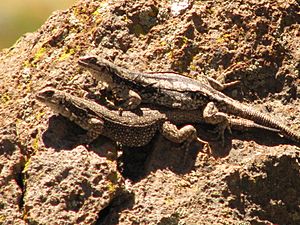Phymaturus payuniae facts for kids
Quick facts for kids Phymaturus payuniae |
|
|---|---|
 |
|
| Conservation status | |
| Scientific classification | |
| Genus: |
Phymaturus
|
| Species: |
payuniae
|
Phymaturus payuniae is a special type of lizard that belongs to the family Liolaemidae. This lizard species lives only in Argentina, a country in South America. It was first described by scientists in 1973.
Contents
Meet the Payunia Lizard
The Payunia lizard, or Phymaturus payuniae, is a fascinating reptile. It's known for living in rocky areas, often found in high-altitude places. These lizards are well-adapted to their environment, blending in with the rocks around them.
What Does It Look Like?
These lizards are usually small to medium-sized. They have strong bodies and scales that help them survive in their rocky homes. Their colors can vary, but they often have patterns that help them camouflage, or hide, from predators. This makes it harder for birds or other animals to spot them.
Where Does It Live?
The Payunia lizard is found in the Payún Matrú volcanic field in Mendoza Province, Argentina. This area is known for its unique volcanic landscapes and dry climate. The lizards live among the rocks, using cracks and crevices for shelter from the sun and cold. They are very good at climbing and moving quickly over rough terrain.
Habitat and Environment
Their habitat is often dry and rocky, with sparse vegetation. They need places to bask in the sun to warm up, as lizards are cold-blooded. They also need shaded spots to cool down when it gets too hot. The rocks provide both warmth and protection.
Life of a Payunia Lizard
Understanding how these lizards live helps us appreciate their unique place in nature.
What Do They Eat?
Most lizards in the Phymaturus genus are herbivores, meaning they eat plants. The Payunia lizard likely feeds on small plants, leaves, and flowers found in its rocky habitat. This makes them an important part of their ecosystem, helping to control plant growth.
How Do They Behave?
Payunia lizards are mostly active during the day, especially when the sun is out. They spend their time looking for food, basking, and watching out for danger. When they feel threatened, they can quickly dart into rock crevices to hide. They are often shy and try to avoid humans.
Reproduction and Life Cycle
Like many lizards, Phymaturus payuniae reproduces by giving birth to live young, rather than laying eggs. This is called viviparity. The mother carries the babies inside her body until they are ready to be born. This can be an advantage in colder climates, as it protects the developing young from harsh temperatures.
Protecting the Payunia Lizard
The conservation status of Phymaturus payuniae is listed as Near Threatened (NT) by the International Union for Conservation of Nature (IUCN). This means that while it's not currently endangered, it could become so in the future if its habitat is not protected.
Why Is It Important to Protect Them?
Every species plays a role in its ecosystem. The Payunia lizard is part of the natural balance in its unique volcanic habitat. Protecting these lizards means protecting their home, which also benefits other plants and animals living there. Scientists continue to study these lizards to learn more about them and how best to ensure their survival.
See also
 In Spanish: Phymaturus payuniae para niños
In Spanish: Phymaturus payuniae para niños


